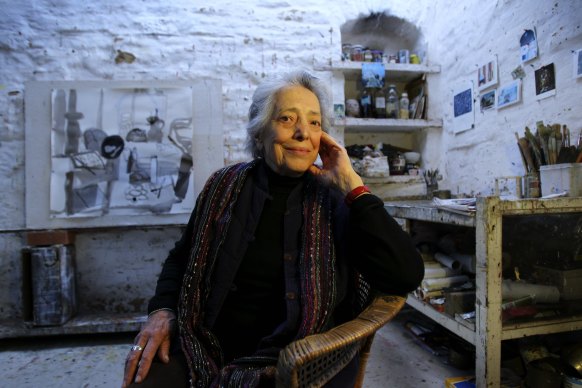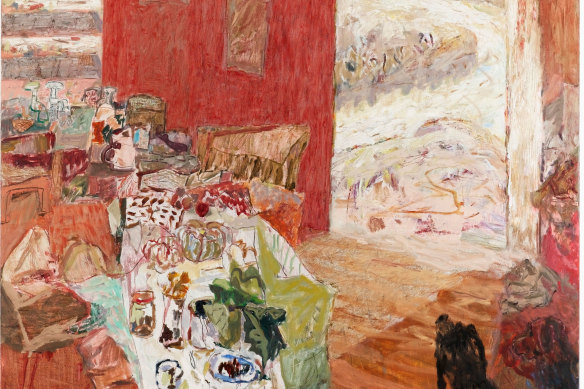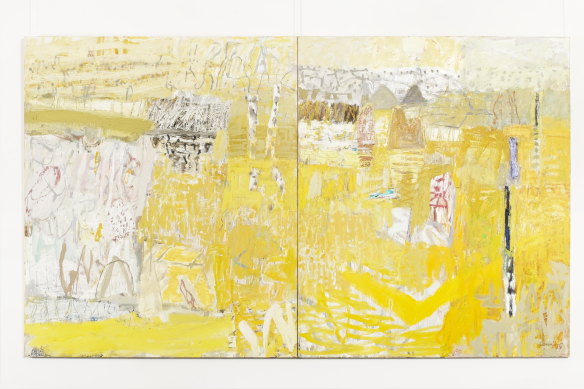Save articles for later
Add articles to your saved list and come back to them any time.
It’s the supreme test of a great artist that their work never grows stale. Upon repeated viewings, conducted over years or even decades, there are paintings that retain their freshness, renewing themselves in front of one’s eyes. As it has been only six years since a survey of Elisabeth Cummings’s work at the S.H. Ervin Gallery, one might assume it was too early for another viewing, but the exhibition at the National Art School Gallery decisively refutes this suggestion.
Elisabeth Cummings at her Wedderburn home. Her work reminds us why we look at paintings.Credit: Anthony Johnson
Elisabeth Cummings: Radiance is one of those rare, truly irresistible displays that reminds us of the fundamental reason we look at paintings: because it is a pleasure, not a chore. There are many shows I attend out of sense of duty, with no expectation of personally liking the work, even if it demands a favourable review. In this case, the best paintings are so “sticky” that as soon as I’d left a room, I felt like going back for a second look.
I’ve written so much about Cummings over the years that I hesitate to trawl back over the story of her career. Suffice to say she was a slow starter who gathered momentum in her 60s and would produce her most important paintings in the decades that followed. It’s not coincidental that her work took off after a 1990 move to Wedderburn, on the outskirts of Sydney. Happily settled in a mud-brick cottage, among a small community of artists, Cummings fell into that zone of perfect concentration that has allowed her to spend months refining a painting. Subject matter was to be found at her front door, although she has often preferred to travel to another part of Australia, or the world, bringing back impressions to be reworked in the studio.
One of the main reasons Cunmings was slow to be noticed is her inherent modesty – not a condition that afflicts many artists. Always feeling she had more to learn, she has quietly outstripped those who think they know it all as her dedication and self-criticism began to produce canvases that could hold their own in any company. From being a marginal, almost invisible presence in the Australian art world, Cummings has risen to a level that should make her an obligatory acquisition for the major public art museums.
While one can only applaud the NAS Gallery for this show, it’s also an implicit indictment of the Art Gallery of NSW, who have consistently ignored the claims of Sydney’s best-known artists. Cummings is 89 this year and will probably never be honoured by the state gallery within her lifetime – making her a member of a depressingly large club.
If Cummings deserves more attention, it’s not only because of the quality of her work, it’s because she is extremely popular. This show has enjoyed booming attendances, while an excellent catalogue may soon need to be reprinted. Among Sydney artists she is a rock star, with hardcore fans and dozens of emulators.
The shearers’ kitchen, Mt Murchison (2011): Cummings’ palette becomes lighter and brighter.
Radiance concentrates on the work of the past 30 years, when Cummings really began to find her feet. In her earlier pictures her admiration for artists such as Bonnard and Vuillard could be easily detected, and traces still linger in her later paintings. Picasso famously despised Bonnard for his “indecision”, but this is precisely the quality Cummings seems to adore. In a classic Bonnard painting, forms and colours appear provisional, with edges blurred. Shadows are patches of colour, subjects suspended somewhere between reverie and reality.
We see these same tendencies in a painting such as The Music Room (1996), in which Cummings creates a heavily abstracted image of a crowded chamber lit by the glare from a single window. The interior is dark and intimate, but outside the sun is shining ferociously. It suggests that music is a world within a world, an interiorised experience that requires a certain distance, as one sense is privileged over the others. In the rhythms of the brushstrokes, we find analogies for the rhythms of a musical composition.
There are a series of pictures in this show in which this dialogue between inner and outer worlds is echoed, with a door or window providing the connection. It’s a device found in many of Matisse’s works. With Cummings, the most dramatic and vibrant example may be The shearer’s kitchen, Mt. Murchison (2011), where a blaze of sunlight enters by a wide open portal to illuminate a heavily laden table. In the corner, two dogs watch at a respectful distance.
In the years that separate The Music Room from The shearers’ kitchen, Cummings’ palette becomes lighter and brighter. Landscapes such as After the fires, Wedderburn (1994) or Bird in the bush (1995) are painted in shades of grey, brown, black and a murky yellow ochre. They are tremendously suggestive of the colours of the bush ravaged by fire, and dappled light filtered through the leaves of the gum trees.
On the way there are paintings such as Dry riverbed and rock forms (1994), where the pink-grey tonality and patchwork brushstrokes recall mid-career Philip Guston. It’s possibly the most singular picture in the show – the kind of work art historians call “transitionary”.
By 2000 she was painting The river, a two-metre-long vista in which we feel the powerful horizontal movement of a waterbed bathed in sunlight. The greys and dull ochres are still present, but now suffused with the radiance that gives this exhibition its completely appropriate title.
It’s this brightness that dominates the exhibition, giving Cummings’ late work an electric charge in paintings such as After the wet, Elcho Island (2004), Edge of the Simpson Desert (2011), or White Billabong (2002). We accept these canvases as landscapes, but it is their abstract qualities that hold our attention. The paintings have been put together layer upon layer, with frequent corrections and rethinkings; areas have been painted out or scratched back in; busy, calligraphic marks and lazy, looping brushstrokes create a sense of constant movement. The eye is never allowed to rest, being hustled from one part of the painting to the next, as if there is so much to see one can’t afford to linger too long in any one place. If Bonnard is the presiding spirit in the early work, the later pictures feel more indebted to the churning, restless energy of Willem de Kooning.
After the wet, Elcho Island (2004): abstract qualities hold our attention.
Cummings’ excitement in these paintings is almost palpable. We feel her absorption in the work, and the pleasure it affords her, as she thinks back over the details of a landscape she is recreating in the studio. The paintings are visual diaries of impressions and sensations, stored away in the back of the artist’s mind, to be reactivated in the present. One thought, one gesture, leads to another. Cummings is not simply painting what she saw but what she felt, and this can only be done in the language of abstraction. It’s her achievement to take this language, often thought of as difficult or obscure, and create paintings with such an immediate, almost visceral appeal. If happiness could be stored in a jar and spread on a canvas, this is the way it might look.
Elisabeth Cummings: Radiance is at the National Art School Gallery until October 21.
To read more from Spectrum, visit our page here.
The Booklist is a weekly newsletter for book lovers from books editor Jason Steger. Get it delivered every Friday.
Most Viewed in Culture
From our partners
Source: Read Full Article





